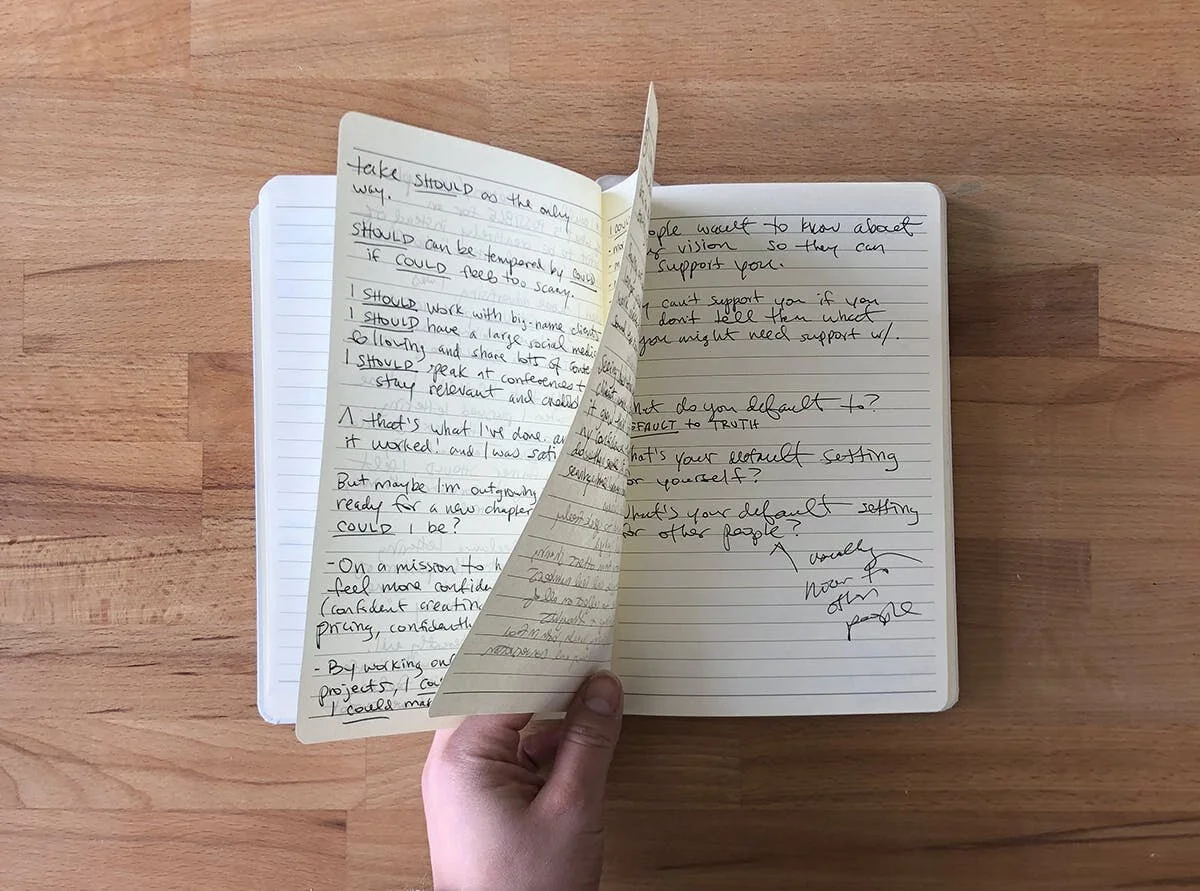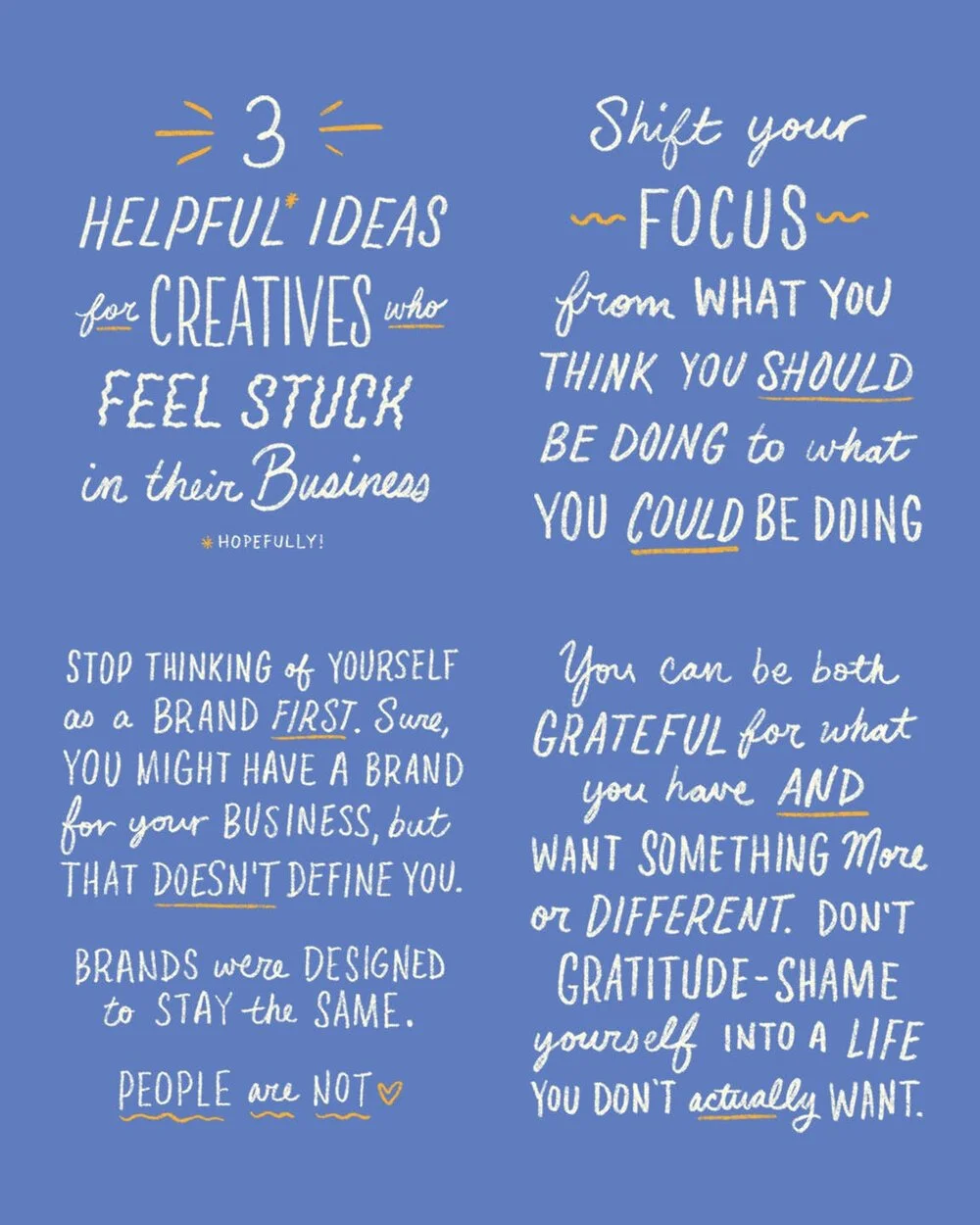WEEK 9 - When my brain is cluttered, this helps...
I consider myself a naturally messy person because I can tolerate a bunch of stuff hanging around.
But I have a limit!
Once the mess gets to a certain level I go through and clear everything out - if it doesn’t go in a nicely organized space it gets donated or tossed.
This cycle of accumulation and organization works really well for me in terms of my physical spaces, so I started thinking about how I tackle my “mental” clutter and it’s actually a very similar process!
Once every three months or so, I do a massive brain dump and get everything out on paper so I can see it all in one place.
Having allllll my creative thoughts in my brain in front of me on a piece of paper, instead of swirling around in my head, allows me to notice trends in my interests.
That clarity gives me the information I need to organize my creative goals and processes. It also helps me put some projects to bed or breathe new life into old abandoned ideas.
Basically, by laying all my mental clutter out in front of me in written form, I can easily see what needs to be organized, hibernated, or forgotten.
The true value of this kind of practice is in the way it highlights things that are important. If I just can’t stop writing about it, that’s probably something I need to pay attention to.
If I’m avoiding writing about it, that can be an indication that I’m not feeling the excitement anymore and need to let that idea rest.
Those kinds of realizations are GOLD for a creative entrepreneur!
Just a few of my many pages of brain scribbles!
I used to use the Notes App on my phone to do this kind of brain-dump exercise - and that’s definitely what you can use if that works best for you.
But in the last year or two I’ve been making a real effort to do this specific kind of journaling on paper. Not just because it makes a great record to go back over later on (it does) but also because I’ve learned there are some serious brain-positive perks to hand writing, including a boost to the creative parts of your brain and to the bits that control working memory.
Us visual creatives should definitely be using the powerful neurological benefits of handwriting to our advantage!
Finally, one of the nicest things about doing this kind of exercise is that there are no value judgements. It’s kind of like writing in a diary, actually, because no one is going to see the clutter but you.
This whole exercise is a low-stakes way to get some clarity on what matters and what doesn’t so that your way forward is a little more obvious (and tidy).
Which brings me to this week’s assignment…
Your assignment: Write about your creative life (personal or professional) for 15-30 minutes and then create artwork about 1-3 main takeaways from what you wrote.
Thought starters: The point is to get all the associated mental clutter out of your brain and onto paper so you have it all in front of you instead of floating around taking up valuable space in your head. Do that however works best for YOU.
Possible themes:
professional goals
a current project you’ve been working on
your ideas (or lack thereof haha)
something that is challenging you in your creative business
anything else related to your creative life
Caption ideas: Talk about the journaling process - how did it feel, what parts were beneficial to you? You can also go into detail about your realizations and how they shaped your associated art piece.
If one (or some) of your takeaways included something actionable, talk about how you’re going to tackle that.
Resources: For the journaling part of this assignment, try handwriting if at all possible. Here are a few interesting facts about handwriting (vs. typing):
Has a similar effect on our brains as meditation, can lower stress, and can help with depression (!).
Improves working memory and promotes learning + cognitive development.
Activates the parts of our brain associated with kinetic (touch-based) creativity because it helps make connections between abstract concepts and concrete practices.
And here are some articles and studies explaining why handwriting is good for our brains:
Handwriting Vs. Typing (The Guardian - Neuroscience)
Three Ways Handwriting Positively Affects Your Brain (Forbes)
Bring Back Handwriting: It’s Good For Your Brain (Medium - Elemental)
The Pen is Mightier Than The Keyboard (Princeton study)
And, as always, don’t forget to tag me @homsweethom and #HOMwork2021 + #HOMwork if you post your work to Instagram. I love looking through your excellent creations and share a few of my favs every week in my IG Stories before the next assignment is posted.
x Lauren
P.S. Last call to join (and get the early bird pricing for) my portfolio updating course starting on Monday 3/15! If you’ve been dragging your feet on updating yours and want some structure, guidance and accountability to finally get it done over the course of the next month, click here to learn more.
What this 4-week live class will include:
Every Monday morning, you’ll receive an email with a video lesson (aka a recording of me working on my portfolio and walking you through my process) and links to any additional resources I mention.
Every Thursday from 11am - 12pm ET, I’ll be available for live office hours where you can ask me questions about that week’s lesson, get feedback on your progress, or just learn from other people’s questions.
You’ll receive lifetime access to the video lessons and the recordings of the office hours.
If you still have questions after reading more about it here, feel free to reply to this email and I’d be happy to answer them for you!


